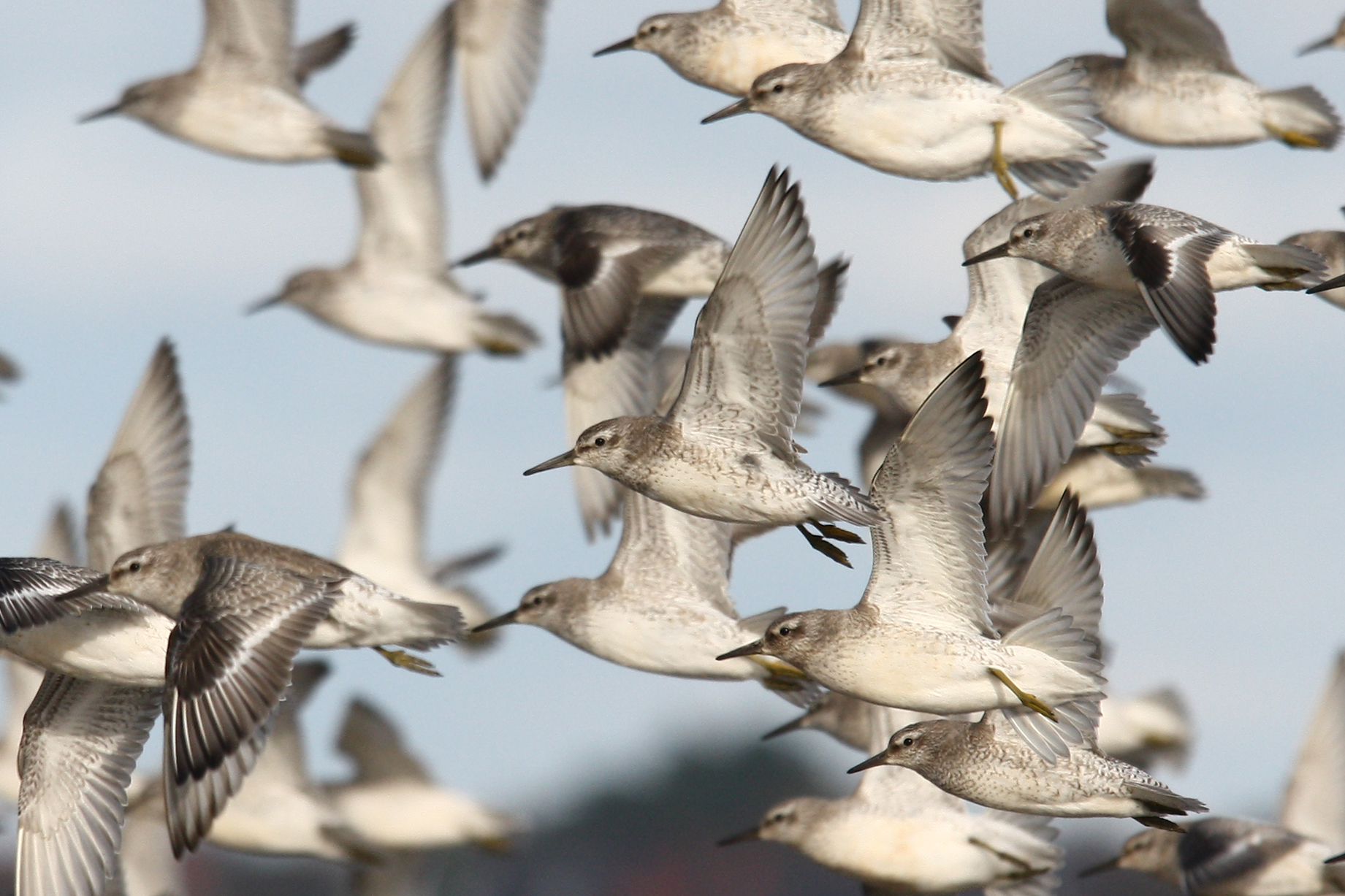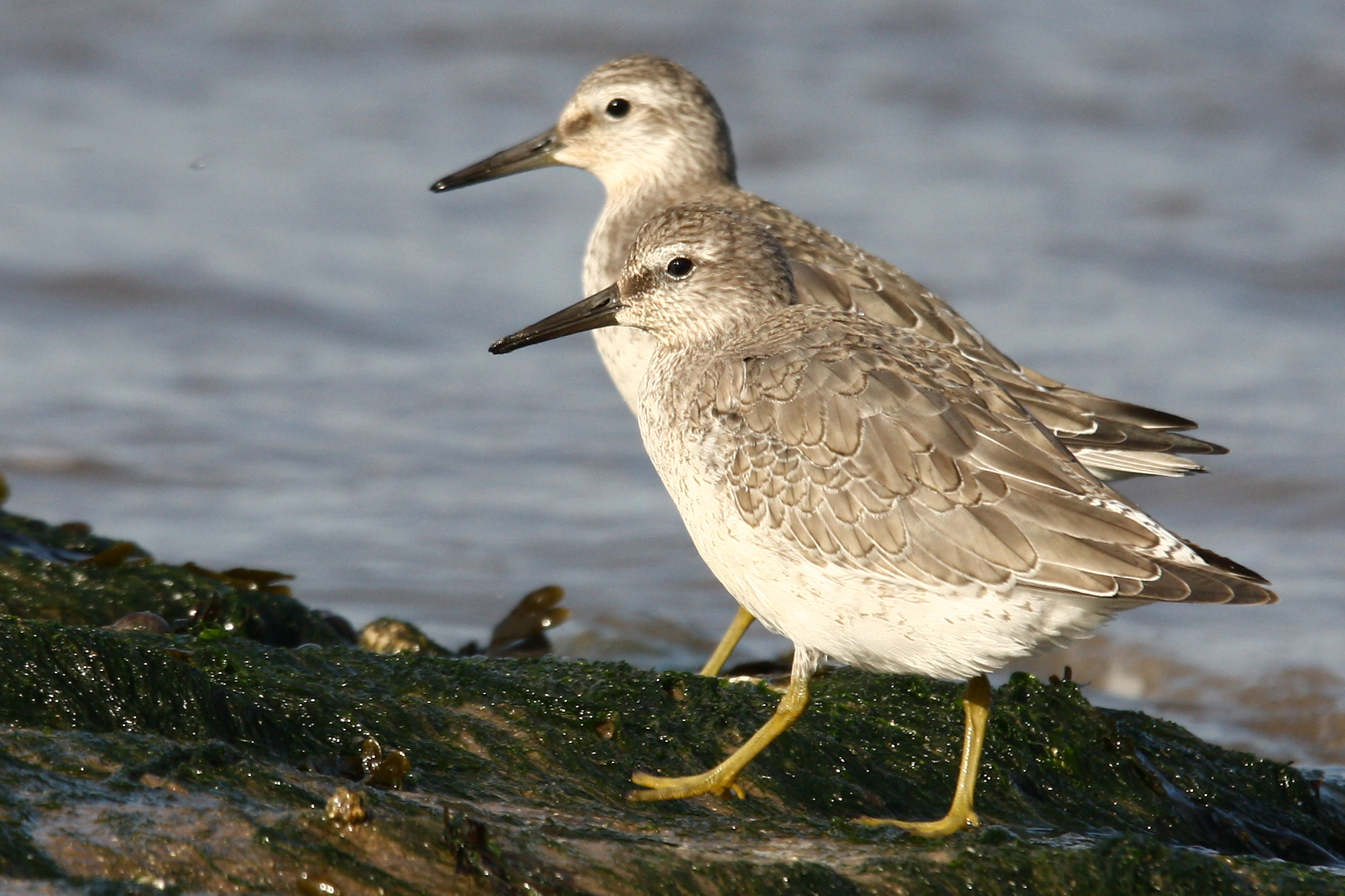As 2030 Approaches, the Flyway Calls for Action
Millions of Birds, One Flyway and a Global Test of Resilience

A flock of Red Knots in graceful formation over the shoreline, showcasing their long-distance migratory prowess. © Thurstaston
As the world rushes towards 2030, migratory birds are sending a signal, one shaped by shifting seasons, disappearing wetlands, and accelerating climate pressure. Along the East Atlantic Flyway, a 15,000-kilometer corridor linking over 1,500 wetlands across 33 countries, the wings of waterbirds carry an urgent message: the efforts taken are not sufficient to achieve our ambitious goals for 2030, and future conservation and climate actions must take root in every landscape they traverse.
A Wake-Up Call in the Wind
The conservation of migratory species and their habitats is a target of the 2030 Global Biodiversity Framework. However, the results captured in the East Atlantic Flyway Monitoring Assessment 2023 offer a sobering picture of gains, losses, and growing differences in conservation outcomes along this critical route.
In January 2023, over 13,000 observers participated in an extensive coordinated waterbird census along the East Atlantic Flyway, and the data revealed that 42 percent of the monitored waterbird populations are increasing, especially in areas benefiting from robust protection frameworks and long-term conservation funding. But 33 percent are declining, with the steepest losses among species breeding in the Arctic and wintering in Afro-tropical regions, including the West African coast, where wetlands are under intensifying pressure.
These aren’t just fluctuations in population dynamics. They reflect deeper, systemic stress: wetland degradation, overfishing, pollution, and the mounting toll of climate-driven shifts.
Intensive monitoring and research efforts give the first indications of how climate change effects are now contributing to species declines. Red Knots are the best-studied example of climate change impacts in migratory waterbirds. In response to inadequate conditions for rearing their chicks in the Arctic Tundra, morphological changes such as shorter beaks have been observed. While wintering in the Banc d’Arguin, these youngsters can no longer access the most nutritious food sources, with long-term effects on their survival. Other species like the Bar-tailed Godwits shorten their stay in stopover sites like the Wadden Sea to catch up with the earlier hatching of mosquitoes in the Arctic. Shorter refuelling time equates to lower body condition, affecting their breeding success.
These birds are suffering from our planet’s health in real time, and the message is clear – we need to do more.

From Data to Action: A Webinar That Mattered
Most species are not as intensively studied as the iconic Red Knot or the Bar-tailed Godwit. To make informed decisions, we need to bridge the gap between data needs and data availability. The EU-funded FLYWAY project, coordinated with support from the Common Wadden Sea Secretariat (CWSS), has been exploring a suite of tools to improve bird monitoring, designed to identify key bottlenecks for migratory species.
“Monitoring is more than counting birds, it’s how we track change in ecosystem quality and ecosystem services.” -Marc van Roomen, Sovon.
Documented changes in bird populations can have different causes: low breeding success, low survival of chicks or adults, but also changes in their migration patterns.
Drone-assisted bird counts in the Bijagós Archipelago of Guinea-Bissau, where dense colonies of terns inhabit remote islands, reveal the number of breeding pairs or even eggs being laid.
Monitoring individual spoonbill chicks, marked with colour rings at their breeding sites in the Wadden Sea, can provide information on their movement and survival along the Flyway. Tracking movements of individual birds in Mauritania’s Banc d’Arguin reveals seasonal changes in the use of intertidal habitats critical to species like the Red Knot.
At the site level, mobile tools like JotForm allow field teams to log habitat status and local threats in real time. These tools, co-developed with partners across the Flyway, are not academic exercises. They are hands-on solutions supporting the rangers, scientists, and communities managing wetlands every day. Expanding these efforts with the latest remote-sensing technologies can provide detailed information on changes in habitat conditions of local wetlands and allow linking it with changes in bird numbers.
Spotlight on the Flyway
On 26 June 2025, these tools and findings came into sharp focus during the CREAF webinar From Data to Action: Strengthening Site-Based Conservation Along the East Atlantic Flyway. The event convened Flyway experts to ask a critical question: what now?
Marc van Roomen, responsible for the Wadden Sea Flyway Initiative’s monitoring programme at Sovon, opened the session with hard data. “Some populations are improving,” he explained. “But declines in Afro-tropical and Arctic regions highlight where support in monitoring and management is needed. We need frameworks that go beyond the numbers to interpret these trends in the local context.”Slide by slide, webinar participants saw how drones, satellite imagery, and digital reporting can be applied to improve site-level management, from the Wadden Sea to South Africa.
Khady Gueye, responsible for Wetlands International Africa's biodiversity management, brought grounded truth to the discussion. “We have passionate local teams,” she said. “But they face real barriers: limited equipment, short-term projects, and staff turnover. What we need is continuity, support that lasts beyond funding cycles.” Her call underscored a reality long felt across the Flyway: commitment exists. What’s lacking is long-term investment.
Wetlands Are Lifelines
Across the Flyway, wetlands support far more than birds. In Yawri Bay, Sierra Leone, they provide vital resources for daily survival. “Shellfish harvesting is one of our main livelihoods,” one community leader shared. “But with the tides rising and pollution increasing, the harvest is no longer what it used to be.”
In Senegal’s Saloum Delta, mangrove forests act as nurseries for local fish species and as powerful carbon sinks. They stabilise coastlines, support fisheries, and store carbon at rates comparable to tropical rainforests. But they are threatened by urban encroachment and declining rainfall.
Globally, more than 20 percent of wetlands have been lost since 1970, and 1 out of 4 remaining wetlands is in a poor ecological state. According to the Convention on Wetlands, erosion is not just ecological, it’s economic, cultural, and existential. Wetlands regulate water cycles, protect against floods, store carbon, and provide food and income for millions. Losing them weakens our collective climate resilience.
Matching Local Action with Global Ambition
What makes the Flyway approach extraordinary is not just its relevance for biodiversity, but the cooperation it inspires, from the local to the global level. The flyway work aligns with many global environmental frameworks: the Global Biodiversity Framework, AEWA’s action plans, and the Convention on Wetlands’ Strategic Plan. But it also supports the Sustainable Development Goals on climate, ecosystems, education, and partnerships. Monitoring birds has the potential to help understand and manage local challenges.
But implementation isn’t automatic. These frameworks only deliver impact when supported by local people, individuals restoring mangroves, tracking species, training rangers, and managing wetlands with local knowledge and limited resources. Strengthening the capacities of local communities to take a key role in wetland management is therefore at the heart of our Climate Resilient East Atlantic Flyway project (CREAF).
The Flyway Is Speaking
There’s no time left for passive reflection. Paying close attention to the birds will tell us everything we need to know to conserve wetlands and wildlife for future generations. The 2023 Monitoring Assessment gave us the evidence. The webinar brought the expertise. The sites provide the solutions.
What remains is the will to act. The Flyway is speaking through every missed arrival, every eroded shore, and every person holding the line between collapse and resilience.
Are we listening?
Learn more about the report and the outcomes of the EU-funded FLYWAY project: https://zenodo.org/records/15423626
